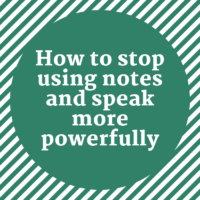Most people use some form of notes when they are speaking. It could be cue cards, a piece of paper or even PowerPoint slides. Have you ever noticed how powerful it is when a speaker doesn’t use notes? Think about a keynote speech at a conference or a TED speaker you may have seen. What impact did it have on you? In most cases, the result is a very engaging and persuasive speech.
But what are the advantages to speaking without notes?
- You can concentrate on not only the content, but also the delivery.
- Your eyes are free to make eye contact and connect with your audience.
- Your hands are free so you can use better gestures and body language.
- Your head is looking forward and not down, so you can project your voice better.
- You know the material and are free to improvise if the situation requires it.
Are those things you want to achieve in your next speech? Then here are some steps you can take to stop using notes.
Practice, Practice, Practice
The reason most people need notes is because they haven’t spent enough time practising. Nancy Duarte, presentation design guru, outlines in her book Slide:ology how much time it takes on average to prepare a one hour presentation. There is a lot of time spent planning, researching and designing. However, most importantly, 3 hours are spent practising.
The more you practice, the better you will know the material and the less likely you are to be constantly referring to your notes. Obviously, it is easier to give a shorter presentation without notes, than a longer one. However, depending on the importance of presentation, it is up to you to decide if you want to practice more so that you can deliver without notes and make a more powerful presentation.
Make the Transition Gradually
If you want to speak without notes, it doesn’t mean that you have to stop using notes immediately. You can gradually put less and less on your cue cards or papers. As you become more confident, you can prepare notes and bring them with you, but leave them to the side and only reference them if you absolutely need to.
Some people like to use presentation slides to help them remember what comes next. This can work at the beginning, but be careful using slides as a crutch. This can backfire if you are not careful. If you rely too much on the slides, you will spend more time looking at them than at the audience. Even worse, you will probably begin to turn your back on the audience as you look at the slides.
Don’t be Afraid of Mistakes
As Michael Erard points out in his book Um…, we make on average one error for every 10 words we say. For instance, every 4.4 seconds there is a disfluency in our speech (um, ah, repeated word). Every 1000 words we make a slip of the tongue, such as ‘bunch lox’ instead of ‘lunch box’. Therefore, your goal shouldn’t be to be the perfect speaker, but instead an excellent speaker. In fact, there is a psychological phenomenon called the Pratfall Effect which explains that competent people who make mistakes are more likeable. This is because people feel that you are flawed just like them and they connect better with you. Therefore, don’t be afraid if you make a few mistakes during your presentation.
Techniques to Cover Up Mistakes
Just because you’ve made a mistake in a presentation doesn’t mean that your audience will notice. Many times you will think the mistake is bigger than it actually is. In some cases the audience might not even know. Here are some suggestions on how to reduce the impact of mistakes in certain circumstances:
- If you forget what part comes next, it’s ok to take a longer pause. Pauses can be and should be used to separate parts of your speech. If you are using pauses, a longer pause will hardly be noticed.
- If you are really stuck, jump to the next section of the presentation. Try at least memorising the key phrases that begin each section of your presentation. This way if you really can’t think of what you were supposed to say next, you can jump to the next section. Obviously, this is not ideal, but you can always come back to the missing points later, by saying “To build on what I was saying earlier…”
- If the mistake is really obvious, why not make a joke out of it? Using humour can diffuse a tense situation. For example, if the previous speaker forgot to turn off his microphone back stage, make a joke about that voice being your mother, wife, ghost or something else. It also brings the problem to the attention of the technical team.
Agree? Disagree? Let us know below.


No comments yet.